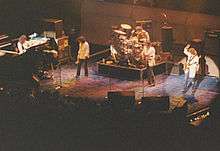Proto-prog
| Proto-prog | |
|---|---|
| Stylistic origins | |
| Cultural origins | Mid-1960s |
| Derivative forms | |
| Other topics | |
Proto-prog (short for proto-progressive)[1] is the advanced music that slightly predates the progressive rock era (before the year 1969).[2] Those proto-prog musicians harnessed modern classical and other genres usually outside of traditional rock influences, longer and more complicated compositions, interconnected songs as medley, and studio composition.[3] Progressive rock (earlier known as "progressive pop")[4] evolved from psychedelic/acid rock music,[5] specifically a strain of classical/symphonic rock led by the Nice, Procol Harum, and the Moody Blues.[6]
Definition

Author Doyle Greene believes that the "proto-prog" label can stretch to "the later Beatles and Frank Zappa", Pink Floyd, Soft Machine, and United States of America.[3] Edward Macan says that psychedelic bands like the Nice, the Moody Blues, and Pink Floyd represent a proto-progressive style and the first wave of English progressive rock.[7] Although a unidirectional English "progressive" style emerged in the late 1960s, by 1967, progressive rock had come to constitute a diversity of loosely associated style codes.[8] When the "progressive" label arrived, the music was dubbed "progressive pop" before it was called "progressive rock",[4][nb 1] with the term "progressive" referring to the wide range of attempts to break with standard pop music formula.[10]
Both the Beach Boys' Pet Sounds (1966) and the Beatles' Sgt. Pepper's Lonely Hearts Club Band (1967), with their lyrical unity, extended structure, complexity, eclecticism, experimentalism, and influences derived from classical music forms, are largely viewed as beginnings in the progressive rock genre.[11][nb 2] Critics assumed King Crimson's album In the Court of the Crimson King (1969) to be the logical extension and development of late 1960s proto-progressive rock exemplified by the Moody Blues, Procol Harum, Pink Floyd, and the Beatles.[13] According to Macan, the album may be the most influential to progressive rock for crystallizing the music of earlier "proto-progressive bands ... into a distinctive, immediately recognizable style".[14] He distinguishes 1970s "classic" prog from late 1960s proto-prog by the conscious rejection of psychedelic rock elements, which proto-progressive bands continued to support.[1]
List of artists
Notes
- ↑ From about 1967, "pop music" was increasingly used in opposition to the term "rock music", a division that gave generic significance to both terms.[9]
- ↑ Describing Pet Sounds as "unprecedented" for the way its "notes moved and vibrated across the record", music critic Joel Freimark says that "many may struggle to see the direct link between the bright, bouncy tones of Pet Sounds and bands like the Beatles, Jimi Hendrix and countless prog-rock bands."[12]
References
- 1 2 3 Macan 2005, p. xxiii.
- ↑ Sositko, Jason (May 8, 2015). "What Are the Best Proto-Prog Rock Albums of All-Time?". Spacial Anomaly.
- 1 2 3 4 5 6 7 Greene 2016, p. 182.
- 1 2 Moore 2004, p. 22.
- ↑ Holm-Hudson 2013, p. 85.
- ↑ "Prog-Rock". AllMusic.
- 1 2 3 4 Holm-Hudson 2013, p. 84.
- ↑ Cotner 2000, p. 90.
- ↑ Gloag, Kenneth (2006). Latham, Alison, ed. The Oxford Companion to Music. Oxford: Oxford University Press. ISBN 0-19-866212-2.
- ↑ Haworth & Smith 1975, p. 126.
- ↑ Macan 1997, p. 15,20.
- ↑ Freimark, Joel (January 26, 2016). "Brian Wilson tours to celebrate 50th anniversary of 'Pet Sounds'". Death and Taxes Mag.
- 1 2 3 4 Macan 2005, p. 75.
- ↑ Macan 1997, p. 23.
- ↑ McCormick, Neil (12 March 2016). "Keith Emerson, the father of progressive rock, was the Jimi Hendrix of keyboards". The Telegraph.
Bibliography
- Cotner, John S. (2000). "Music Theory and Progressive Rock Style Analysis". Reflections on American Music: The Twentieth Century and the New Millennium. Pendragon Press. ISBN 978-1-57647-070-1.
- Greene, Doyle (2016). Rock, Counterculture and the Avant-Garde, 1966–1970: How the Beatles, Frank Zappa and the Velvet Underground Defined an Era. McFarland. ISBN 978-1-4766-2403-7.
- Haworth, John Trevor; Smith, Michael A. (1975). Work and Leisure: An Interdisciplinary Study in Theory, Education and Planning. Lepus Books.
- Holm-Hudson, Kevin, ed. (2013). Progressive Rock Reconsidered. Routledge. ISBN 978-1-135-71022-4.
- Macan, Edward (1997). Rocking the Classics: English Progressive Rock and the Counterculture. Oxford University Press. ISBN 978-0-19-509887-7.
- Macan, Edward (2005). Endless Enigma: A Musical Biography of Emerson, Lake and Palmer. Open Court. ISBN 978-0-8126-9596-0.
- Moore, Allan (2004). Jethro Tull's Aqualung. Bloomsbury Publishing. ISBN 978-1-4411-1315-3.